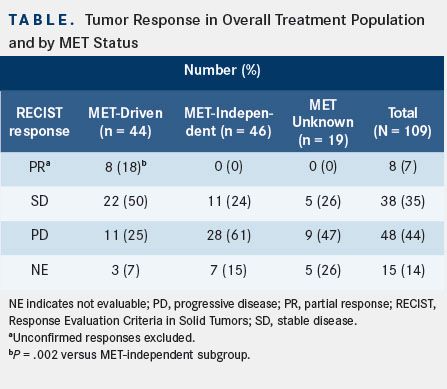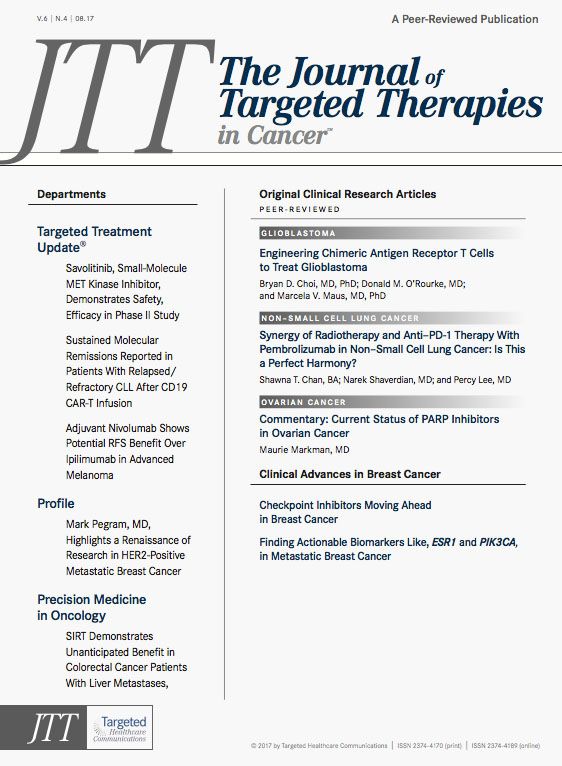Savolitinib, Small-Molecule MET Kinase Inhibitor, Demonstrates Safety and Efficacy in Phase II Study
Patients with metastatic papillary renal cell carcinoma have limited therapeutic options, but results of a phase II safety and efficacy study suggest that a small-molecule inhibitor, savolitinib, could help patients with MET-driven disease.
1Results, published in the Journal of Clinical Oncology, suggest that savolitinib holds promise as a personalized treatment for a subgroup of patients with metastatic PRCC, the researchers from the Dana-Farber Cancer Institute in Boston, said in a statement.
Of the 109 patients treated, 44 (40%) had MET-driven and 46 (42%) had MET-independent PRCC. MET status was undetermined in 19 patients. PRCC may involve activation of this pathway, through either gene amplification or mutations.
The investigators reported that patients with histologically confirmed locally or advanced metastatic PRCC received a once-daily 600-mg dose of savolitinib orally until progression or treatment discontinuation criteria were met.
The objective response rate (ORR) was 7%. When MET status was determined, ORR was 18% in patients with MET-driven PRCC (8 partial responses [PRs]) compared with MET-independent PRCC (0% PR; P = .002). Further, stable disease was achieved in 22 patients (50%) with MET-driven disease and 11 (24%) with MET-independent disease(TABLE).
In addition, the length of time after treatment before the cancer began growing was significantly longer in the MET-driven tumor group: 6.2 months versus 1.4 months. The authors will continue to follow patients to allow further assessment of the difference in progression-free survival and provide data on overall survival.

The investigators reported MET copy number gain (either chromosomal or focal) in 72% of type 1 PRCCs and 46% of type 2 PRCCs, which is comparable with previous reports of MET copy gain in 81% and 46% of type 1 and type 2 PRCCs, respectively.
“These data support the hypothesis that savolitinib has antitumor activity in patients with MET-driven papillary renal cell carcinoma,” the authors said in the statement. The study “identified a defined molecular group and highlights the prevalence of MET-driven disease in this rare population of RCC patients.”
The researchers concluded that MET status was more predictive of response to savolitinib in the study than was a classification based on pathology; all partial responders had archival tumor samples that harbored a copy number gain in the MET pathway (HGF, MET, or chromosome 7), some in combination with a MET kinase domain mutation. This suggests that genomic profiling can better identify patients who may respond to savolitinib than can the type 1 or type 2 histologic subtype, adding relevance to the use of genomic profiling in such studies.
Overall, savolitinib was generally well tolerated, with nausea, fatigue, and vomiting reported as the most common adverse events (AEs). These were similar to AEs reported by patients with PRCC who received foretinib, a MET/ VEGFR2 inhibitor in a prior study.2Other AEs occurring in ≥10% of patients were peripheral edema, increased alanine aminotransferase and aspartate transaminase levels, serum creatinine increase, and decreased appetite.
In the United States alone, about 6400 cases of PRCC are expected to be diagnosed in 2017, compared with a total of 64,000 cases of kidney cancers. The majority of these cancers are classified as clear cell renal cell cancers. PRCC is classified as nonclear cell kidney cancer.3

Beckermann and Participants Discuss Second-Line ccRCC Options
January 22nd 2025During a Case-Based Roundtable® event, Kathryn E. Beckermann, MD, PhD, discussed second-line regimens with event participants depending on their own practice and trial data for a patient with clear cell renal cell carcinoma.
Read More
Enhancing Precision in Immunotherapy: CD8 PET-Avidity in RCC
March 1st 2024In this episode of Emerging Experts, Peter Zang, MD, highlights research on baseline CD8 lymph node avidity with 89-Zr-crefmirlimab for the treatment of patients with metastatic renal cell carcinoma and response to immunotherapy.
Listen
Beyond the First-Line: Economides on Advancing Therapies in RCC
February 1st 2024In our 4th episode of Emerging Experts, Minas P. Economides, MD, unveils the challenges and opportunities for renal cell carcinoma treatment, focusing on the lack of therapies available in the second-line setting.
Listen
What Is Dark Zone Lymphoma, and Is It Clinically Relevant?
January 16th 2025Dark zone lymphoma includes aggressive B-cell lymphomas with shared molecular features. While some respond to escalated treatment, others remain resistant, highlighting the need for targeted approaches to improve outcomes.
Read More